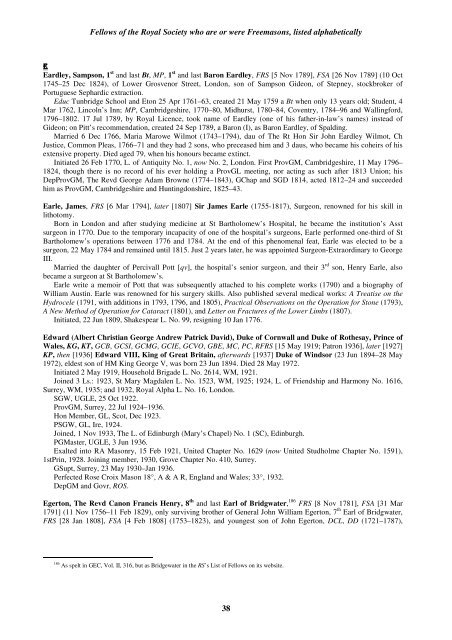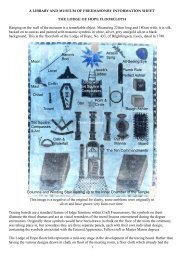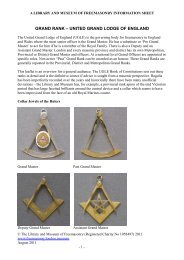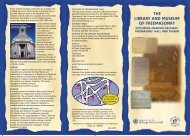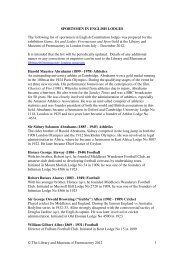FREEMASONS AND THE ROYAL SOCIETY Alphabetical List of ...
FREEMASONS AND THE ROYAL SOCIETY Alphabetical List of ...
FREEMASONS AND THE ROYAL SOCIETY Alphabetical List of ...
Create successful ePaper yourself
Turn your PDF publications into a flip-book with our unique Google optimized e-Paper software.
Fellows <strong>of</strong> the Royal Society who are or were Freemasons, listed alphabetically<br />
E<br />
Eardley, Sampson, 1 st and last Bt, MP, 1 st and last Baron Eardley, FRS [5 Nov 1789], FSA [26 Nov 1789] (10 Oct<br />
1745–25 Dec 1824), <strong>of</strong> Lower Grosvenor Street, London, son <strong>of</strong> Sampson Gideon, <strong>of</strong> Stepney, stockbroker <strong>of</strong><br />
Portuguese Sephardic extraction.<br />
Educ Tunbridge School and Eton 25 Apr 1761–63, created 21 May 1759 a Bt when only 13 years old; Student, 4<br />
Mar 1762, Lincoln’s Inn; MP, Cambridgeshire, 1770–80, Midhurst, 1780–84, Coventry, 1784–96 and Wallingford,<br />
1796–1802. 17 Jul 1789, by Royal Licence, took name <strong>of</strong> Eardley (one <strong>of</strong> his father-in-law’s names) instead <strong>of</strong><br />
Gideon; on Pitt’s recommendation, created 24 Sep 1789, a Baron (I), as Baron Eardley, <strong>of</strong> Spalding.<br />
Married 6 Dec 1766, Maria Marowe Wilmot (1743–1794), dau <strong>of</strong> The Rt Hon Sir John Eardley Wilmot, Ch<br />
Justice, Common Pleas, 1766–71 and they had 2 sons, who preceased him and 3 daus, who became his coheirs <strong>of</strong> his<br />
extensive property. Died aged 79, when his honours became extinct.<br />
Initiated 26 Feb 1770, L. <strong>of</strong> Antiquity No. 1, now No. 2, London. First ProvGM, Cambridgeshire, 11 May 1796–<br />
1824, though there is no record <strong>of</strong> his ever holding a ProvGL meeting, nor acting as such after 1813 Union; his<br />
DepProvGM, The Revd George Adam Browne (1774–1843), GChap and SGD 1814, acted 1812–24 and succeeded<br />
him as ProvGM, Cambridgeshire and Huntingdonshire, 1825–43.<br />
Earle, James, FRS [6 Mar 1794], later [1807] Sir James Earle (1755-1817), Surgeon, renowned for his skill in<br />
lithotomy.<br />
Born in London and after studying medicine at St Bartholomew’s Hospital, he became the institution’s Asst<br />
surgeon in 1770. Due to the temporary incapacity <strong>of</strong> one <strong>of</strong> the hospital’s surgeons, Earle performed one-third <strong>of</strong> St<br />
Bartholomew’s operations between 1776 and 1784. At the end <strong>of</strong> this phenomenal feat, Earle was elected to be a<br />
surgeon, 22 May 1784 and remained until 1815. Just 2 years later, he was appointed Surgeon-Extraordinary to George<br />
III.<br />
Married the daughter <strong>of</strong> Percivall Pott [qv], the hospital’s senior surgeon, and their 3 rd son, Henry Earle, also<br />
became a surgeon at St Bartholomew’s.<br />
Earle write a memoir <strong>of</strong> Pott that was subsequently attached to his complete works (1790) and a biography <strong>of</strong><br />
William Austin. Earle was renowned for his surgery skills. Also published several medical works: A Treatise on the<br />
Hydrocele (1791, with additions in 1793, 1796, and 1805), Practical Observations on the Operation for Stone (1793),<br />
A New Method <strong>of</strong> Operation for Cataract (1801), and Letter on Fractures <strong>of</strong> the Lower Limbs (1807).<br />
Initiated, 22 Jun 1809, Shakespear L. No. 99, resigning 10 Jan 1776.<br />
Edward (Albert Christian George Andrew Patrick David), Duke <strong>of</strong> Cornwall and Duke <strong>of</strong> Rothesay, Prince <strong>of</strong><br />
Wales, KG, KT, GCB, GCSI, GCMG, GCIE, GCVO, GBE, MC, PC, RFRS [15 May 1919; Patron 1936], later [1927]<br />
KP, then [1936] Edward VIII, King <strong>of</strong> Great Britain, afterwards [1937] Duke <strong>of</strong> Windsor (23 Jun 1894–28 May<br />
1972), eldest son <strong>of</strong> HM King George V, was born 23 Jun 1894. Died 28 May 1972.<br />
Initiated 2 May 1919, Household Brigade L. No. 2614, WM, 1921.<br />
Joined 3 Ls.: 1923, St Mary Magdalen L. No. 1523, WM, 1925; 1924, L. <strong>of</strong> Friendship and Harmony No. 1616,<br />
Surrey, WM, 1935; and 1932, Royal Alpha L. No. 16, London.<br />
SGW, UGLE, 25 Oct 1922.<br />
ProvGM, Surrey, 22 Jul 1924–1936.<br />
Hon Member, GL, Scot, Dec 1923.<br />
PSGW, GL, Ire, 1924.<br />
Joined, 1 Nov 1933, The L. <strong>of</strong> Edinburgh (Mary’s Chapel) No. 1 (SC), Edinburgh.<br />
PGMaster, UGLE, 3 Jun 1936.<br />
Exalted into RA Masonry, 15 Feb 1921, United Chapter No. 1629 (now United Studholme Chapter No. 1591),<br />
1stPrin, 1928. Joining member, 1930, Grove Chapter No. 410, Surrey.<br />
GSupt, Surrey, 23 May 1930–Jan 1936.<br />
Perfected Rose Croix Mason 18°, A & A R, England and Wales; 33°, 1932.<br />
DepGM and Govr, ROS.<br />
Egerton, The Revd Canon Francis Henry, 8 th and last Earl <strong>of</strong> Bridgwater, 186 FRS [8 Nov 1781], FSA [31 Mar<br />
1791] (11 Nov 1756–11 Feb 1829), only surviving brother <strong>of</strong> General John William Egerton, 7 th Earl <strong>of</strong> Bridgwater,<br />
FRS [28 Jan 1808], FSA [4 Feb 1808] (1753–1823), and youngest son <strong>of</strong> John Egerton, DCL, DD (1721–1787),<br />
186 As spelt in GEC, Vol. II, 316, but as Bridgewater in the RS’s <strong>List</strong> <strong>of</strong> Fellows on its website.<br />
38


